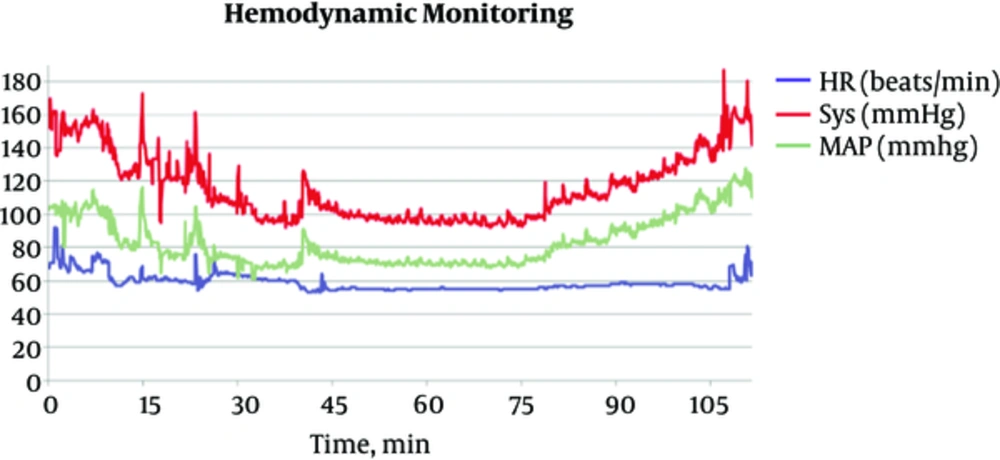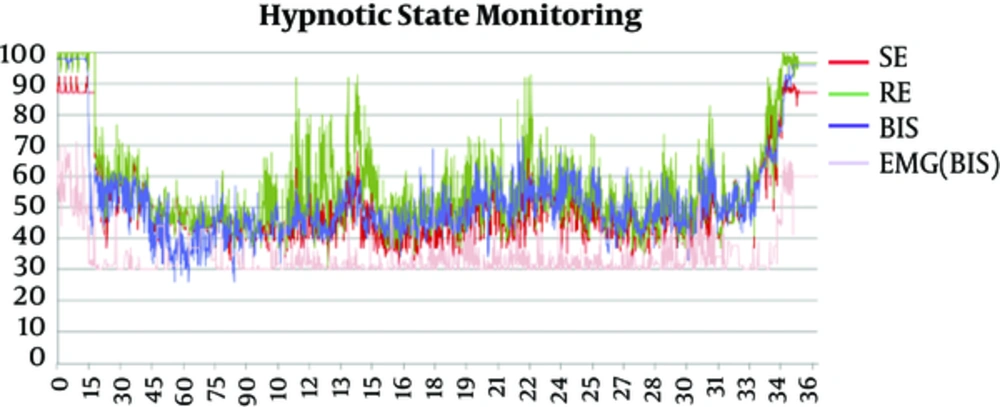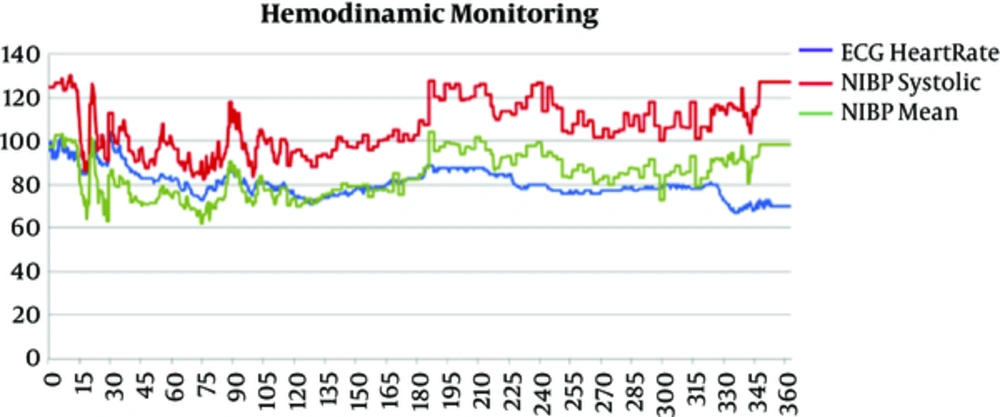1. Introduction
Narcolepsy is a chronic neurological disorder that effects sleep regulation. It is characterized by uncontrollable daytime sleep episodes and, in some cases, cataplexy (1). Narcoleptic patients may be at increased risk of prolonged emergence, postoperative hypersomnia, apneic episodes, and sleep paralysis after general anesthesia (2-7). Modafinil is the first-line treatment of excessive daytime sleepiness (8), however, the implication it has on general anesthesia is not clear.
We present 2 cases of narcoleptic patients medicated with modafinil that were submitted to general anesthesia for neurosurgical procedures.
2. Materials and Methods
Two clinical reports are presented following obtainment of informed consent of both patients. Clinical information was obtained based on the patients’ interviews and medical records. Regarding collection of intraoperative data, in both cases Datex Ohmeda monitor for ASA standard monitoring was used and bispectral index (BIS) and Entropy monitors were employed for depth of anesthesia monitoring. The different monitors were connected to a dedicated computer and Rugloop software was used to collect data from all monitors every 5 seconds. The Rugloop data was exported to an excel sheet using Labgrab, which allowed for the analysis of the data. In one of the patients the cardiac output was also monitored and recorded using LiDCO rapid, which allowed direct exportation to an Excel sheet. In the second patient, the ANI monitor was used, which is a monitoring system of the parasympathetic tone. Unfortunately, it was not possible to extract ANI values.
3. Results
3.1. Case Report No. 1
The first case was a 35-year-old male, classified as ASA physical status 2, with a history of narcolepsy, who required general anesthesia for lumbar herniated disk surgery.
The day before surgery the patient was observed and a pre-operative anesthesia assessment was performed. The patient described episodes of excessive sleepiness and cataplexy since adolescence, as well as occasional occurrence of sleep paralysis. He had been diagnosed with narcolepsy with cataplexy, 2 years before the surgery. He was medicated with modafinil 200 mg daily, remaining asymptomatic ever since. He underwent an appendectomy at the age of 21 under general anesthesia without known complications. At the time of the present surgery, the patient’s weight was 91 kg and body mass index was 27 kg/m2. Both the physical examination and laboratory tests were normal. After a literature search, it was decided that the patient should take his morning dose of modafinil; surgery was scheduled to start at 8 AM.
Intraoperatively, the ASA standard monitoring was used, plus neuromuscular blockade and invasive arterial pressure (using Datex Ohmeda Aisys). Bispectral index (BIS) and entropy were both monitored to guide the anesthesia level and possibly increase the information on the hypnosis in case there was difficulty in awakening from anesthesia. The BIS, muscle tone activity (EMG), state entropy (SE), and response entropy (RE) values were recorded throughout the procedure. Cardiac output was monitored using LiDCO rapid.
Total intravenous anesthesia with remifentanil and propofol by target-controlled infusion (TCI) was performed, using the base primea orchestra from fresenius kabi. Anesthesia was induced with remifentanil to achieve a target cerebral concentration (Ce) of 2.5 ng/mL (Minto’s Pharmacokinetic model), followed by 1% propofol at 200 mL/h until loss of consciousness (LOC), which happened after 148 mg of propofol were infused. At the moment of LOC, the predicted cerebral concentration (Ce) of propofol was 5.9 ug/mL (Schnider’s Pharmacokinetic model). At that moment, the pump was switched to TCI mode and a cerebral target concentration of 3.7 ug/mL was set, according to a previously published formula, aiming at keeping the BIS between 40 and 60 (9, 10). Rocuronium was administered at 0.6 mg/kg. After tracheal intubation, propofol target Ce was reduced to 3.0 ug/mL and remifentanil was reduced to a target Ce of 1.0 ng/mL. The patient was then placed in jack-knife position.
Anesthesia was maintained with remifentanil and propofol by TCI, both titrated to keep BIS between 40 and 60. The BIS and Entropy were slightly above 60 mmHg occasionally and this was associated with the presence of EMG activity (Figure 1). A total of 924 mg of propofol and 1726 ug of remifentanil were administered. During surgery, propofol Ce varied between 1.5 and 2.5 ug/mL, while remifentanil Ce varied between 0.7 and 4.5 ng/mL. The patient was submitted to mechanical ventilation in controlled volume mode. Ventilation parameters were set in order to obtain a target ETCO2 of 35 mmHg. No additional neuromuscular blockers were given. Intravenous acetaminophen 1 g and parecoxib 40 mg were administered for post-operative analgesia and the surgical wound was infiltrated with ropivacaine 0.375% before skin closure.
The duration of anesthesia was 104 minutes. At the end of surgery, the TOF had spontaneously recovered to 100%. Propofol infusion was stopped and remifentanil infusion was continued at a Ce 2 ng/mL throughout the recovery phase. After repositioning the patient in supine position, he immediately opened his eyes, followed commands and calmly removed the tracheal tube himself, following the instructions provided by the anesthesiologist.
The hemodynamic alterations were recorded throughout the procedure (Figures 2 and 3). On arrival at the operating room, the patient presented an arterial pressure of 150/75 mmHg, which corresponds to a mean arterial pressure (MAP) of 100 mmHg. After the start of remifentanil and propofol perfusions, his arterial pressure declined, as expected, and the lowest value of MAP was 58 mmHg. The patient presented a hypertensive response to tracheal intubation (173/90 mmHg) and jack-knife positioning (161/72 mmHg). During surgery, the cardiac output varied between 4.4 and 5.9 l/minute (Figure 3). At the end of the surgery, with the reduction of propofol and remifentanil perfusion, the arterial pressure increased gradually and with supine positioning, awakening, and extubation, the patient presented another hypertensive response (186/91 mmHg).
Key points in the procedure with hemodynamic response are the following: Start of remifentanil - 7 minutes; start of propofol - 9 minutes; tracheal intubation - 15 minutes, Jack-knife positioning - 22 minutes, surgical incision - 40 minutes, end of surgery - 103 minutes, supine position and eye opening - 108 minutes, extubation - 109 minutes.
At the end of surgery, the patient was transferred to the post-anesthesia care unit (PACU), where he remained, alert and oriented for 90 minutes. The remifentanil perfusion was progressively reduced and no additional opioids were needed for pain control. No narcolepsy events occurred at the ward, the patient slept normally that night, and was discharged home the following day. Postoperative interviews were performed and no signs of awareness or recall were detected.
3.2. Case Report No. 2
A 37-year-old-female with a history of narcolepsy was submitted to anterior cervical spinal decompression (C3 - C6) under general anesthesia.
A pre-anesthetic evaluation was performed on the day before surgery. The patient reported episodes of uncontrollable daytime sleepiness, cataplexy, and sleep paralysis since late adolescence. The diagnosis of narcolepsy was made 4 years before surgery and since then she had been prescribed modafinil 100 mg twice daily, at breakfast and after lunch. However, for economical reasons, she was only taking the morning dose of modafinil and had 3 to 5 narcolepsy-cataplexy episodes every week, including on the day of the visit. On that day, she had instantly fallen asleep while she was sitting on her bed, almost falling to the floor. She was awakened by a nurse, who was passing by.
For chronic pain due to the cervical stenosis, the patient was medicated with gabapentin and clomipramine. Her medical history included Raynaud phenomenon, which was being treated with nifedipine, sclerodactyly, and she was being studied for scleroderma. She also had mild aortic valve regurgitation and gastroesophageal reflux disease that was being treated with omeprazole. The patient’s anesthetic and surgical history included only a caesarean section at age 24, under neuraxial anesthesia with no complications. The patient weighed 51 kg, had a body mass index of 19.0 kg/m2, and was classified as ASA physical status 3.
During the pre-anesthetic visit, she was instructed to take 200 mg of modafinil on awakening, approximately 2 hours before surgery, instead of the 100 mg twice a day.
Intraoperatively, in addition to ASA standard monitorization, a neuromuscular blockade monitor, BIS, Entropy, and analgesia nociception index (ANI) were used. This patient was also submitted to total intravenous anesthesia with remifentanil and propofol by TCI. After administration of lignocaine 40 mg and dexamethasone 8 mg, induction was performed as in the the first case, with TCI remifentanil set to achieve Ce 2.5 ng/mL and propofol 1% perfusion 200 mL/h until LOC. The dose of propofol needed for LOC was 89 mg, which corresponded to a Ce 4.2 ug/mL (Schnider pharmacokinetic model). After LOC, propofol TCI was set to Ce 3.1 ug/mL, which was calculated using the same formula as in case no. 1 (9, 10), and rocuronium was administered at a dose of 0.6 mg/kg. Due to the cervical lesion, videolaryngoscopy (Glidescope) was used for intubation, which was successfully done at the first attempt.
The duration of anesthesia was 5 hours and 35 minutes. During surgery, propofol was titrated according to BIS and Entropy, and remifentanil was titrated according to ANI monitoring, in order to maintain ANI values between 50 and 70. Propofol Ce varied between 1.3 and 3.5 ug/mL and remifentanil Ce between 1.0 and 11.0 ng/mL. A total of 2220 mg of propofol and 4560 ug of remifentanil were administered. The BIS and Entropy varied mostly between 40 and 60 (Figure 4). A rocuronium perfusion was used to maintain a deep blockade between 1 to 3 post tetanic counts (PTC) and a total of 360 mg was administered during the 290 minutes of perfusion. At the end of surgery, the rocuronium perfusion was stopped and a PTC of 10 was detected by TOF-Watch. Sugammadex was administered at a dose of 4 mg/kg and TOF ratio recovered to 1. The perfusion of propofol was suspended and remifentanil Ce maintained at 2.0 ng/mL. After 4 minutes and 22 seconds, the patient opened her eyes spontaneously, was able to follow commands and was calmly extubated, in less than 1 minute. The remifentanil perfusion was maintained in the PACU (Ce 2.0 ng/mL) and gradually reduced allowing the postoperative analgesia to take effect. In the PACU she received 1 g of acetaminophen and 40 mg of parecoxib. As the remifentanil perfusion was lowered, every 10 minutes, IV morphine was titrated to the patient’s needs, according to a pain visual analogue scale, in a total of 8 mg. The patient remained in the PACU for approximately 2 hours alert, oriented and cooperative. In the remaining 4 days of hospitalization in the Neurosurgical ward, the patient complied to the narcoleptic medication and had no complications or narcolepsy-related events.
The hemodynamic parameters of this patient are presented in Figure 5. Following start of propofol and remifentanil perfusions, there was a decrease of arterial pressure from 125/82 mmHg to 86/55 mmHg. With tracheal intubation, the arterial pressure rose to 125/79 mmHg. During surgery, mean arterial pressure varied between 62 and 104 mmHg. After emergence from anesthesia and extubation, the arterial pressure increased to 127/78 mmHg, similar to the initial value.
4. Discussion
These two narcoleptic patients subjected to intravenous anesthesia had no complications. The anesthetic requirements may be considered normal and emergence from anesthesia was very fast.
In both cases, propofol for induction was given at 200 mL/h and not as a bolus. This was done to allow for the detection of the cerebral predicted concentration at which LOC occurred, which could later be used to better titrate anesthesia depth. The amount of propofol required for LOC in the first patient was 1.6 mg/kg within 4.4 minutes and in the second case this was 1.7 mg/kg in 2.7 minutes. These doses are within the recommended dose when induction is performed by bolus. The predicted propofol Ce at LOC was 5.9 ug/mL in the first case, which can be considered a high concentration and 4.2 ug/mL in the second, which can be considered an average concentration (11).
Various factors may have contributed to the rapid emergence and uneventful recovery observed in both cases. First of all, it was decided not to administer sedative premedication and the anesthetic drugs selected were propofol and remifentanil because of their rapid onset and short context-sensitive half-times. Monitoring of the hypnotic state was used to adjust the target concentrations of propofol and avoid possible prolonged emergence. Entropy was monitored in order to add information about the EEG and hypnosis/consciousness. In the second patient, ANI was used for better titration of analgesia and to avoid administration of excessive doses of opioid, which could contribute to delayed emergence and excessive sedation in the post-operative period. During maintenance, BIS and Entropy varied mostly between 40 and 60 (Figures 1 and 4) and their values were always very close, changing in parallel. In the first patient, the average administered doses of propofol (5.9 mg/kg/hour) and remifentanil (0.18 μg/kg/minute) were close to the inferior limit of the recommended doses (6 - 10 mg/kg/hour and 0.1 - 0.5 μg/kg/minute, respectively (12)). Anesthetic emergence (eye opening) was achieved in 3 minutes and the tracheal tube was removed only 1 minute after opening the eyes. In the second case, the average administered dose of propofol was 7.8 mg/kg/hour and remifentanil was 0.26 μg/kg/minute, which are within the recommended doses. Anesthetic emergence occurred in 4 minutes and 22 seconds and the tracheal tube was removed in less than a minute after she opened her eyes.
In the first patient, opioids were not used other than remifentanil, since it was possible to provide adequate analgesia with acetaminophen, parecoxib and infiltration of the surgical wound with a local anesthetic. In the second case, in addition to acetaminophen and parecoxib, morphine was carefully administered in the PACU to control post-surgical pain. The patient did not present excessive sleepiness or apneic episodes.
Narcolepsy is characterized by uncontrollable daytime sleep episodes and, in most cases, cataplexy. The treatment of excessive daytime sleepiness was traditionally based on amphetamines, yet, has now been widely replaced by modafinil. Modafinil was approved by the food and drug administration in 1998 for narcolepsy, however, the precise mechanism through which modafinil promotes wakefulness is still unknown (13). Cataplexy is reduced by antidepressant drugs, such as tricyclic antidepressants, selective serotonin reuptake inhibitors, and noradrenergic uptake inhibitors. In the first patient narcolepsy was well controlled with modafinil, while the second patient did not comply with the medication and had narcoleptic episodes. Nonetheless, the outcomes of both patients were similar. The continuation of modafinil on the day of surgery might have contributed to the rapid emergence of both patients. The high Ce of propofol required for LOC (11) in the first patient may be due to the fact that he had taken modafinil. The implication that modafinil therapy has on general anesthesia is not clear. Postoperative administration of 200 mg of modafinil improved feelings of alertness and energy in patients with no sleep disorder, after general anesthesia (14). Despite being pharmacologically different from amphetamines, modafinil also elicits adrenergic activation, leading to increased levels of catecholamines, heart rate, and blood pressure (15). There were concerns that long-term use of modafinil would lead to catecholamine depletion and could blunt the sympathetic response to hypotension after induction and jack-knife positioning, therefore, the decision was made to use LiDCO Rapid. In both patients, a decrease in arterial pressure occurred after anesthesia induction, yet, they did not require vasopressors and the arterial pressure rapidly increased after tracheal intubation. In fact, the first patient presented hypertensive responses to intubation and surgical positioning, as described above.
5. Conclusions
Based on the literature review and the cases presented here, it could be concluded that continuation of modafinil in the pre-operative period, including on the day of surgery, may contribute to rapid and complete recovery of consciousness. Sedative premedication should be avoided and the use of short-acting anesthetic agents such as propofol and remifentanil through TCI most likely improves titration of anesthesia. Anesthesia depth monitors are important to optimize anesthetic administration.




